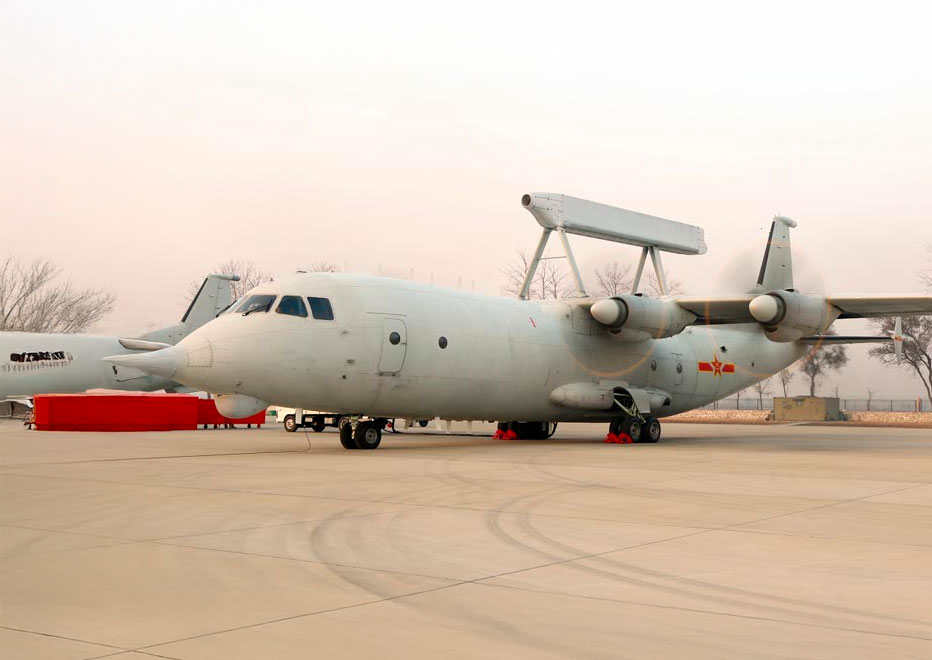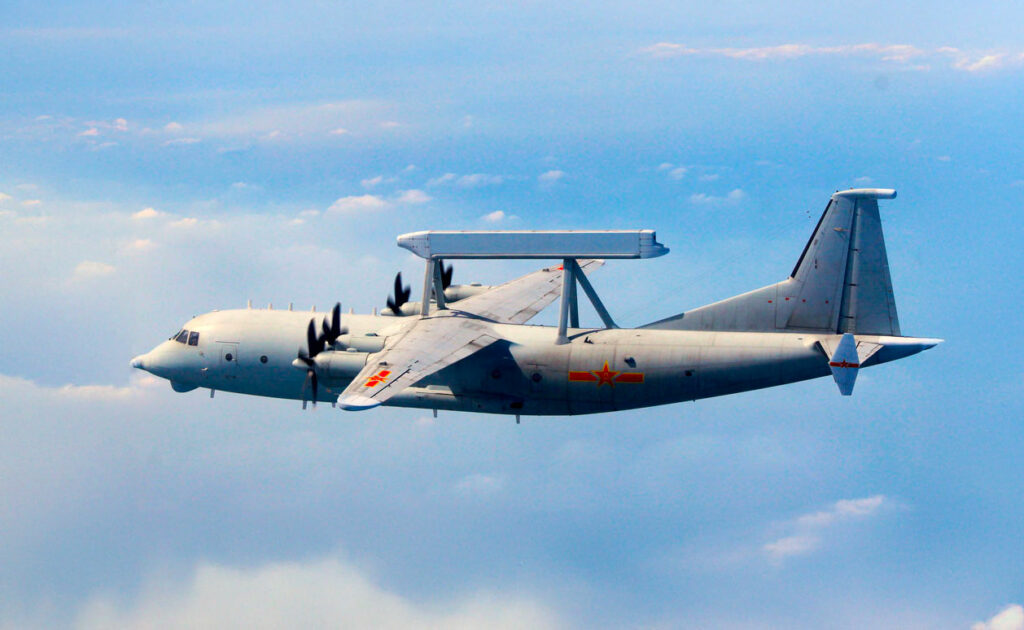Shaanxi KJ-200: AEW&C aircraft with AESA radar, based on the Y-8 airframe, optimized for early warning and surveillance.
In brief
The Shaanxi KJ-200 is an airborne early warning and control (AEW&C) aircraft developed by China’s Shaanxi Aircraft Corporation. The aircraft is based on the Y-8 transport platform, with modifications for advanced radar capabilities. It uses four Zhuzhou WoJiang-6 turboprop engines, each producing 4,250 horsepower, enabling a maximum speed of 410 mph (660 km/h). The KJ-200 can operate at altitudes up to 34,121 feet (10,400 meters) and has a range of 3,480 miles (5,600 km), making it suitable for extended missions. Equipped with an Active Electronically Scanned Array (AESA) radar in a “balance beam” configuration, it provides comprehensive airspace surveillance. The KJ-200 supports the People’s Liberation Army Air Force (PLAAF) and Navy, offering a cost-effective solution for aerial reconnaissance and early threat detection.

The Shaanxi KJ-200
The development of the KJ-200 represents a strategic move by China to expand its airborne early warning capabilities. As military technology advanced into the 21st century, the need for robust, homegrown AEW&C solutions became apparent for the Chinese military. Unlike older platforms that relied on foreign technology, the KJ-200 was designed to enhance national defense with indigenous radar and avionics. Initiated in 2001, the KJ-200 project aimed to develop an aircraft that could provide real-time aerial surveillance, capable of tracking multiple targets and directing military assets. This aircraft is widely recognized as a vital component of China’s expanding AEW&C fleet, with its distinctive “balance beam” radar design inspired by the Swedish Saab Erieye system. The KJ-200 was officially introduced in 2009, with early prototypes entering testing by mid-2000s.
History of the Development of the Shaanxi KJ-200
The Shaanxi KJ-200 traces its origins back to the early 2000s, a time when China was looking to modernize its air force with enhanced reconnaissance and early warning capabilities. Previously, China had attempted to procure AEW&C technology from other countries, such as the ill-fated deal with Israel for the PHALCON radar system in the late 1990s. However, when international pressure ended this deal, China was prompted to develop its own systems. The KJ-200 project began in 2001, utilizing the Shaanxi Y-8 airframe, which itself was derived from the Soviet Antonov An-12. By adapting this reliable platform, China aimed to create a domestic AEW&C aircraft capable of providing coverage over extensive areas.
One of the KJ-200’s first significant events was the tragic crash in 2006 during a test flight, which resulted in the loss of the prototype and its crew. Despite this setback, the project continued, and by 2009, the KJ-200 was fully operational. The aircraft has since been a part of China’s AEW&C fleet, serving both the PLAAF and PLANAF. The KJ-200 has a NATO reporting name of “Moth,” and it supports China’s broader surveillance network, operating in contested regions like the South China Sea. Its development and deployment reflect China’s growing emphasis on self-reliance in defense technology.
Design of the Shaanxi KJ-200
The KJ-200 retains much of the physical structure of the Y-8 transport aircraft but is modified for AEW&C missions. The most prominent feature is the “balance beam” AESA radar mounted atop the fuselage. This radar, resembling Saab’s Erieye system, is fixed in position and mounted on support struts that provide stability. The radar allows 360-degree coverage, critical for detecting aerial threats and directing response assets. Internally, the aircraft includes an all-glass cockpit for enhanced situational awareness and a series of operator stations for mission management.
The KJ-200 is powered by four Zhuzhou WoJiang-6 turboprop engines. These engines are derivatives of the Pratt & Whitney Canada PW150B, known for their durability and efficiency. Each engine drives a six-bladed propeller, providing a balance between speed and range. Although slower than jet-powered AEW&C platforms, the turboprop configuration offers greater fuel efficiency and endurance, suitable for long-duration missions at medium altitudes. The aircraft also includes a tricycle landing gear system, which supports operations from various airfields.
Performance of the Shaanxi KJ-200
The KJ-200’s performance is characterized by its operational range of approximately 3,480 miles (5,600 kilometers) and a maximum speed of 410 mph (660 km/h). With a service ceiling of 34,121 feet (10,400 meters), it can operate effectively above most potential threats. Its four engines provide a combined output of 17,000 horsepower, which supports its substantial takeoff weight of up to 134,482 pounds (61,000 kilograms).
In comparison with other AEW&C aircraft, such as the American E-2 Hawkeye, the KJ-200 offers similar surveillance capabilities at a lower cost, though it lacks some of the Hawkeye’s advanced electronic warfare features. The KJ-200’s AESA radar provides reliable target detection and tracking, while its turboprop engines enable extended mission endurance, especially suitable for patrols over the South China Sea. While it cannot match the speed of jet-powered AEW&C platforms like the E-3 Sentry, the KJ-200 balances capability with affordability, making it a strategic asset for China’s regional air defense.
Variants of the Shaanxi KJ-200
The KJ-200 has several variants adapted for different roles. The primary version is the Y-8 Balance Beam, equipped with the dorsal-mounted AESA radar and optimized for air surveillance. Another version, the KJ-200H, features upgraded avionics and radar systems tailored for maritime patrol and anti-submarine warfare. This version is used primarily by the PLANAF for operations over coastal regions.
The KJ-500 is a more advanced variant based on a similar concept but using a Y-9 airframe. Instead of the balance beam radar, it features a fixed circular radome with three phased-array antennas, which enhances radar coverage and detection capabilities. The KJ-500 serves as a next-generation upgrade to the KJ-200, with improved tracking and electronic warfare features.

Military Use and Combat of the Shaanxi KJ-200
The KJ-200 plays a critical role in the PLAAF and PLANAF, providing early warning and surveillance across China’s vast airspace and maritime zones. While it is unarmed, the KJ-200 supports combat operations by coordinating with fighter jets, ground radar, and missile systems. It is deployed regularly over the East and South China Seas, where it aids in monitoring foreign aircraft and ships operating near disputed territories.
During routine patrols, the KJ-200 has encountered aircraft from neighboring countries, including Japan and South Korea, which often intercept it as it approaches their air defense zones. Such encounters highlight the aircraft’s significance in China’s regional strategy. Additionally, the KJ-200 has been integrated into joint exercises, supporting simulated engagements and command-and-control tasks. Although it has not seen direct combat, its role in intelligence gathering makes it a valuable tool in peacetime and potential conflict scenarios.
The KJ-200 has not been exported, but its technology is foundational for China’s AEW&C expansion, leading to more advanced models like the KJ-500. This fleet expansion allows the PLAAF to maintain continuous surveillance over critical areas, underscoring the KJ-200’s strategic importance in Chinese defense operations.
Back to the Special Aircraft section